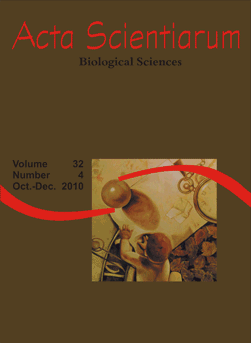<b>Perception and use of fauna resources in communities surrounding a conservation unit in northeast Brazil</b> - doi: 10.4025/actascibiolsci.v32i4.5668
Keywords:
environmental perception, ethnozoology, Caatinga, Seridó ESEC
Abstract
Biodiversity is threatened by many human activities, and the creation of new Conservation Units (CUs) attempts to reduce this threat. However, this alone has not achieved the expected results. Partnerships are being established with local communities through research that includes the perceptions of these individuals. Environmental Perception has been used to understand and improve the people-environment relationship in these areas. The Caatinga Biome suffers threats and losses from anthropogenic action. Few of its areas are protected by CUs and further conservation efforts are needed. The Seridó Ecological Station (Seridó ESEC) is one of the few CUs in the Caatinga of Rio Grande do Norte State (NE Brazil). An Environmental Perception study was carried out in this area using Ethnozoology concepts to investigate the perceptions of the surrounding communities and use of local fauna. Ninety-two interviews were conducted in 4 communities with 514 statements obtained in 58 vernacular names. The animal most cited was the Rhea (bird) with 58 citations. Its main uses were medicinal or as human food. The rich local knowledge observed may be used in a partnership to correctly manage local resources in the Seridó ESEC.Downloads
Download data is not yet available.
Published
2010-10-26
How to Cite
Silva, T. S. da, & Freire, E. M. X. (2010). <b>Perception and use of fauna resources in communities surrounding a conservation unit in northeast Brazil</b> - doi: 10.4025/actascibiolsci.v32i4.5668. Acta Scientiarum. Biological Sciences, 32(4), 365-371. https://doi.org/10.4025/actascibiolsci.v32i4.5668
Issue
Section
Ecology and Limnology
DECLARATION OF ORIGINALITY AND COPYRIGHTS
I Declare that current article is original and has not been submitted for publication, in part or in whole, to any other national or international journal.
The copyrights belong exclusively to the authors. Published content is licensed under Creative Commons Attribution 4.0 (CC BY 4.0) guidelines, which allows sharing (copy and distribution of the material in any medium or format) and adaptation (remix, transform, and build upon the material) for any purpose, even commercially, under the terms of attribution.
Read this link for further information on how to use CC BY 4.0 properly.
0.6
2019CiteScore
31st percentile
Powered by 

0.6
2019CiteScore
31st percentile
Powered by 











1.png)




3.png)













